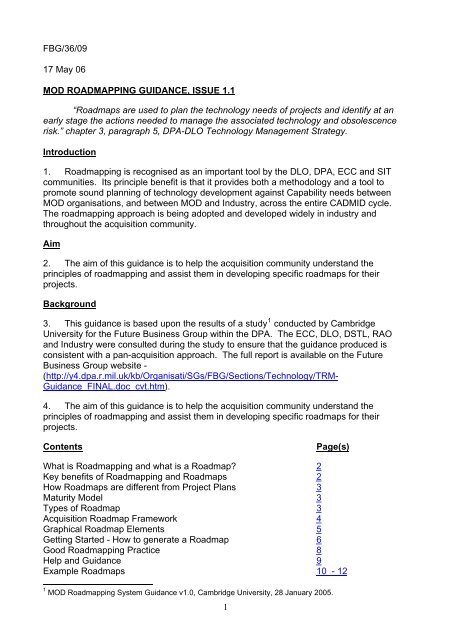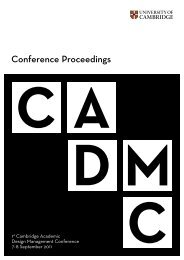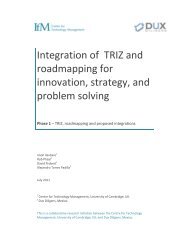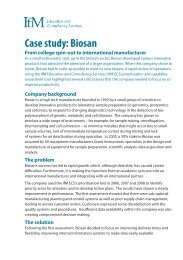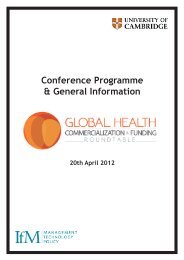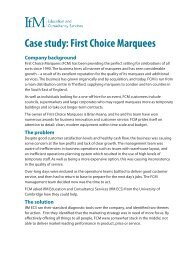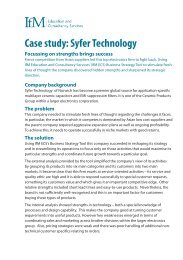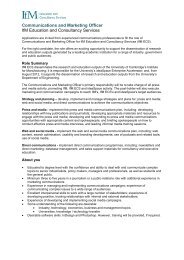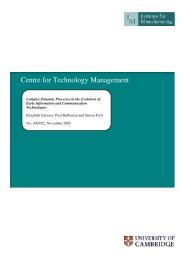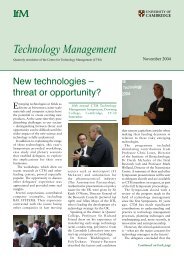Further details are available here
Further details are available here
Further details are available here
You also want an ePaper? Increase the reach of your titles
YUMPU automatically turns print PDFs into web optimized ePapers that Google loves.
FBG/36/09<br />
17 May 06<br />
MOD ROADMAPPING GUIDANCE, ISSUE 1.1<br />
“Roadmaps <strong>are</strong> used to plan the technology needs of projects and identify at an<br />
early stage the actions needed to manage the associated technology and obsolescence<br />
risk.” chapter 3, paragraph 5, DPA-DLO Technology Management Strategy.<br />
Introduction<br />
1. Roadmapping is recognised as an important tool by the DLO, DPA, ECC and SIT<br />
communities. Its principle benefit is that it provides both a methodology and a tool to<br />
promote sound planning of technology development against Capability needs between<br />
MOD organisations, and between MOD and Industry, across the entire CADMID cycle.<br />
The roadmapping approach is being adopted and developed widely in industry and<br />
throughout the acquisition community.<br />
Aim<br />
2. The aim of this guidance is to help the acquisition community understand the<br />
principles of roadmapping and assist them in developing specific roadmaps for their<br />
projects.<br />
Background<br />
3. This guidance is based upon the results of a study 1 conducted by Cambridge<br />
University for the Future Business Group within the DPA. The ECC, DLO, DSTL, RAO<br />
and Industry were consulted during the study to ensure that the guidance produced is<br />
consistent with a pan-acquisition approach. The full report is <strong>available</strong> on the Future<br />
Business Group website -<br />
(http://y4.dpa.r.mil.uk/kb/Organisati/SGs/FBG/Sections/Technology/TRM-<br />
Guidance_FINAL.doc_cvt.htm).<br />
4. The aim of this guidance is to help the acquisition community understand the<br />
principles of roadmapping and assist them in developing specific roadmaps for their<br />
projects.<br />
Contents<br />
Page(s)<br />
What is Roadmapping and what is a Roadmap? 2<br />
Key benefits of Roadmapping and Roadmaps 2<br />
How Roadmaps <strong>are</strong> different from Project Plans 3<br />
Maturity Model 3<br />
Types of Roadmap 3<br />
Acquisition Roadmap Framework 4<br />
Graphical Roadmap Elements 5<br />
Getting Started - How to generate a Roadmap 6<br />
Good Roadmapping Practice 8<br />
Help and Guidance 9<br />
Example Roadmaps 10 - 12<br />
1 MOD Roadmapping System Guidance v1.0, Cambridge University, 28 January 2005.<br />
1
What is Roadmapping and what is a Roadmap?<br />
5. Roadmapping is a strategic planning process which helps to align and communicate<br />
the business need (Know Why), with the delivery programmes (Know What) and the<br />
underpinning resources (Know How). In acquisition terms, it can be used for example to<br />
link Capability needs with Equipment projects and Research activities. The roadmapping<br />
process was first used in the semiconductor industry in the 1970’s to align technology<br />
investments with market and product needs. It is now widespread in industry, with<br />
technology companies such as Motorola and Vodaphone now dependent upon it.<br />
6. Roadmaps <strong>are</strong> the graphical outputs of the roadmapping process, showing the joined<br />
up planning between stakeholders. The most common form of roadmap takes the form of<br />
a multi-layered time based chart as shown in figure 1. This joint integrated planning<br />
approach links resources and activities with the business goals – which in acquisition<br />
terms can be summarised as capability needs.<br />
7. A Roadmap shows the strategic plan for the identification, evaluation and maturation<br />
of alternative technological solutions for achieving a requirement and the route by which<br />
these may be embodied in military systems. It applies throughout the CADMID cycle<br />
whether the technology is to be incorporated into a new design or inserted into an existing<br />
programme post Main Gate.<br />
Figure 1<br />
Key Benefits of Roadmapping and Roadmaps<br />
8. Roadmapping is a powerful management technique. Good roadmaps help deliver<br />
effective technology exploitation, acquisition and insertion. Roadmapping identifies key<br />
synergies, dependencies and gaps within a strategic plan, in order to expose risks or<br />
issues more readily. Roadmapping enables more effective decision making, through better<br />
communication, clarity of thinking, alignment and visibility of programmes or activities.<br />
Roadmaps can help to reduce risk to a degree consistent with delivering an acceptable<br />
level of system performance to required time and cost targets.<br />
2
9. Above all, roadmaps support communication and <strong>are</strong> particularly effective across<br />
disparate teams and organisational boundaries. Within acquisition, roadmaps <strong>are</strong> effective<br />
tools to ensure joined up technology planning between Customer One, the Research<br />
Community, Acquisition Teams and Industry.<br />
How Roadmaps <strong>are</strong> different from Project Plans<br />
10. Roadmaps <strong>are</strong> generally concerned with longer timeframes than the project plans<br />
typically produced by MicroSoft Project. Roadmaps deal with more strategic levels of<br />
information, and as such <strong>are</strong> often concerned with navigating through <strong>are</strong>as of high<br />
uncertainty. The multi-layered approach differentiates a roadmap from a project plan,<br />
helping to present information in a way that aids understanding of the linkages and<br />
dependencies between activities.<br />
Maturity Model<br />
11. Roadmapping can be characterised in terms of a maturity model:<br />
a. Level 1. Roadmaps support communication and common understanding.<br />
b. Level 2. Roadmaps <strong>are</strong> of sufficient quality that they can be used to influence<br />
decisions or persuade people to change their views or behaviour.<br />
c. Level 3. A system of roadmaps has been developed that supports<br />
synchronisation and alignment across the organisation.<br />
12. Many parts of the MOD <strong>are</strong> already developing good roadmaps (e.g. to support Initial<br />
Gate submissions or release research funding) and this can be characterised as sitting<br />
between levels 1 & 2 described above. Key enablers to achieving level 3 maturity <strong>are</strong><br />
common architectures and data formats, which <strong>are</strong> described further in this document. A<br />
Roadmapping Community of Practice 2 has been set up to support convergence towards<br />
the common approach described at level 3 above; this forum also supports and<br />
encourages the sharing of best practice and discussion on the subject of roadmapping<br />
generally..<br />
Types of Roadmap<br />
13. Within Acquisition, three basic types of roadmap have been identified and associated<br />
with different core processes and stakeholder groups (see figure 2). These roadmaps <strong>are</strong><br />
not independent in that they sh<strong>are</strong> a common roadmap architecture and display common<br />
information, such as capability shortfalls, platform in/out service dates and research<br />
programme information. These roadmap views <strong>are</strong> illustrative and should not be viewed<br />
as three discrete types. When a roadmap is being created for a specific purpose, teams<br />
should not feel constrained by these three views. The examples at the end of this<br />
guidance <strong>are</strong> real examples of roadmaps created by project teams, and do not fit neatly<br />
into either of these views.<br />
2 Accessible from the DPA Knowledge Base / Communities / Roadmapping<br />
3
Figure 2<br />
a. Capability roadmaps support the processes leading up to development of the<br />
User Requirements Document (URD). These roadmaps can be considered<br />
‘capability centric’ in that the primary unit of analysis is a particular capability need,<br />
with the owner of the roadmap typically residing within the Equipment Capability<br />
Customer (ECC) organisation. This type of roadmap generally contains links to<br />
multiple systems, equipment types, technologies and possibly other capability <strong>are</strong>as.<br />
b. Exploitation roadmaps support the management of the programmes required to<br />
deliver the required capability through equipment programmes or other lines of<br />
development (LOD). These roadmaps can be considered ‘equipment/other LOD’<br />
centric in that the primary unit of analysis is a particular system/platform or other line<br />
of development. The owner is likely to reside in the DPA or the DLO.<br />
c. Technology roadmaps support the management of technology research and<br />
development programmes. These roadmaps can be considered to be ‘technology<br />
centric’ in that the primary unit of analysis is a particular technology <strong>are</strong>a or<br />
programme, with the owner typically residing within the Research Acquisition<br />
Organisation (RAO) or the Defence Science and Technology Laboratories (DSTL).<br />
14. What is common to all three roadmap types (or ‘views’) is that they sh<strong>are</strong> a common<br />
architecture flexible enough to be adapted for each particular purpose, and they use a<br />
standard set of graphical elements. The standard framework and the standard graphical<br />
elements <strong>are</strong> discussed in more detail later in this document.<br />
Acquisition Roadmap Framework<br />
15. The use of a standard roadmapping framework enables information to be sh<strong>are</strong>d<br />
more effectively across the acquisition community – it should be thought of as a framework<br />
within which key information and relationships can be captured, stored and communicated.<br />
The general MOD-wide framework developed as part of the roadmapping study is shown<br />
4
in figure 3, focusing on the Equipment Line of Development (LOD), with a mapping shown<br />
on the right hand side against the MOD Technology Taxonomy3.<br />
Figure 3<br />
16. The roadmapping framework defined by these layers is not intended to be too<br />
prescriptive. Rather the developers of roadmaps should configure the structure of the<br />
roadmap to suit the particular application under consideration, using these principles as a<br />
starting point. Several examples of roadmaps based on this framework <strong>are</strong> shown at the<br />
end of this guidance.<br />
17. A relevant Capability or R&D level roadmap may already have been created, and EC<br />
or RAO stakeholders will be able to provide these and discuss the linkages with the<br />
Equipment roadmap. If no separate R&D or Capability roadmap exists, these<br />
stakeholders will be able to provide the <strong>details</strong> necessary to include these views in the<br />
overall Acquisition roadmap framework.<br />
Graphical Roadmap Elements<br />
18. The following set of four graphical roadmap elements (shown in figure 4) is the<br />
minimum sufficient to create a roadmap:<br />
Activity, equipment, concept, etc<br />
Set (e.g. NEC)<br />
Milestone<br />
‘Tapered bars’ can be<br />
used to indicate the<br />
range of likely start and<br />
completion dates<br />
Decision<br />
point<br />
Linkages must not go backwards<br />
Linkages<br />
(relationships & causality)<br />
Figure 4<br />
a. Bars - activities, projects, platforms, concepts, future programmes and other<br />
entities that occur over a period of time. ‘Tapered bars’ can be used to show the<br />
likely range of start and completion dates (e.g. 10% and 90% confidence levels).<br />
Note that current best practice uses dotted lines to indicate unfunded tasks.<br />
3 MOD Technology Taxonomy, Version 6, 2004<br />
5
. Diamonds - decision points, milestones, objectives and forecasts that occur at a<br />
single point in time.<br />
c. Arrows - linkages, connecting roadmap elements, to map relationships.<br />
d. Sets - or collections of elements which cannot be easily shown as related by<br />
other means such as the use of colour - e.g. projects and activities in a programme,<br />
or a set of systems that together contribute to a network-enabled capability (see<br />
dotted line in figure 4).<br />
e. A key for any colours, acronymns and line styles used is essential to aid<br />
understanding of your roadmaps.<br />
19. The full consideration of data that could be associated with these graphical elements<br />
(‘metadata’) is described in the full Cambridge University report and may include<br />
information such as: Title of element; Description or summary of element; ‘Owner’ (the<br />
person or group responsible for maintaining the element or data); Time frames (e.g. start<br />
and finish dates); Technology Readiness Levels; Taxonomy references; Status (e.g.<br />
funded or not funded); References to other key documents or roadmaps; Security<br />
classification. Consideration of the data architectures to be used across MOD is the<br />
responsibility of the Roadmapping Community of Practice.<br />
Getting Started – How to Generate a Roadmap<br />
20. Often a small group of individuals can produce a detailed roadmap in short and<br />
focussed meetings. For more complex cases or those involving a large group of<br />
stakeholders, workshops provide a useful mechanism to bring together the range of<br />
stakeholders that need to be involved. This enables the communication and buy-in, data<br />
collection and creativity, particularly at early stages of the process.<br />
21. Cambridge University have developed a ‘fast start’ process for introducing the<br />
roadmapping approach in organisations. This process is called ‘T-Plan’ and is based on a<br />
workshop approach. This approach has been customised for the MOD and <strong>details</strong> <strong>are</strong><br />
contained in the full report (annex D) on the FBG website. In simple terms, the process<br />
uses the low-tech approach of ‘post-it’ notes to capture key information and map this on<br />
the outline roadmap structure shown in figure 3. The photograph in figure 5 shows this<br />
approach in action – it was taken during one of the study pilot roadmapping sessions. A<br />
summarised version of this approach is shown <strong>here</strong>, showing the key planning and<br />
workshop steps involved:<br />
a. Define the reason for developing the roadmap – the problem.<br />
b. Define the boundaries – what is being considered and what is not.<br />
c. Define the aims of the roadmap – why is the roadmap being developed?<br />
d. Ensure that the correct people <strong>are</strong> in attendance to construct the roadmap –<br />
e.g. the example shown in figure 6, involved representatives from the DEC<br />
(capability) IPT (equipment project) and DSTL (science & technology).<br />
e. Use a facilitator who is clear about the purpose of the roadmapping session and<br />
is able to focus and capture the brainstorming involved.<br />
6
f. Ensure attendees come prep<strong>are</strong>d to brief the group should their specific<br />
knowledge be required to get people started.<br />
g. Define the structure of the roadmap using the generic models shown in figures<br />
1 and 3 as a guide – a non-linear timescale and three broad layers <strong>are</strong> appropriate.<br />
h. Construct a large paper version of this outline structure and attach it to the wall<br />
so that all in attendance can see it.<br />
i. Focus on the layer of interest (e.g. for exploitation roadmap the middle layer) -<br />
capture the key activities on ‘Post-it’ notes and place them on the outline paper<br />
roadmap.<br />
j. Capture the key information about each activity – e.g. start & completion date,<br />
activity name and TRLs or taxonomy references, if applicable<br />
k. Link activities appropriately on the chart with a pen, and capture any relevant<br />
information about the nature of the activities or links.<br />
l. Populate the rest of the roadmap layers in a similar fashion capturing related<br />
activities (e.g. underpinning technology development or research programmes and<br />
capability gaps or related capability <strong>are</strong>as). Again link appropriately.<br />
m. A first cut roadmap can then be produced from the paper version, using MS<br />
PowerPoint or another suitable tool.<br />
n. Capture all relevant supporting information and produce a paper (the ‘strategic<br />
narrative’) outlining key background information that complements the summary<br />
information contained in the roadmap.<br />
o. Circulate the first cut roadmap and the ‘strategic narrative’ and refine it and<br />
update it using additional workshops accordingly.<br />
Figure 5<br />
7
22. A workshop is of particular use when it is desirable to involve a reasonably large<br />
group of stakeholders, to sh<strong>are</strong> knowledge and gain buy-in. However some activities <strong>are</strong><br />
best undertaken in small groups. For example, the illustrative roadmaps contained in this<br />
document were created in small group sessions, usually involving four or five people over<br />
periods of a few hours. In each case, the roadmap framework (similar to above) was<br />
populated with information, drawing on programme and technical documentation<br />
supported by expert knowledge and discussion within the group. From this, MS<br />
PowerPoint was used to produce the (sanitised for security purposes) roadmaps shown at<br />
the end of this document.<br />
Good Roadmapping Practice<br />
23. At the early stages, roadmaps <strong>are</strong> likely to have gaps and inconsistencies, but the<br />
quality of the roadmap should improve over time as the strategic plan matures.<br />
Consultation with key stakeholders is vitally important, and the roadmap provides a<br />
mechanism to support this dialogue. Discussion with customers and suppliers (particularly<br />
industry) is vital, to clearly understand requirements and constraints, and to understand<br />
potential acquisition routes, capability and technological options. Several observations on<br />
what a good roadmap should contain have emerged from the study and best practice:<br />
a. A roadmap should include a title and security classification, together with name<br />
and contact <strong>details</strong> for the owner and date that the roadmap was last updated;<br />
b. The architecture should be compatible with the principles set out in this<br />
guidance, in terms of three broad layers;<br />
c. A key should be included to explain the meaning of symbols and colours;<br />
d. A full life cycle view of equipment and platforms should be shown;<br />
e. Colour or other appropriate means should be used to show clearly the funding<br />
status of research or development programmes;<br />
f. In general, a non-linear scale for time is appropriate, with more space given to<br />
the short-term comp<strong>are</strong>d to the long-term;<br />
g. Clear links should be shown to delivered capability, which may require<br />
consideration of additional equipment, systems or platforms (for example if the IPT is<br />
working on equipment that will be inserted into another platform);<br />
h. Clear links between research projects should be shown, and how these feed<br />
into equipment programmes;<br />
i. The roadmap should include key milestones and decision points, for example,<br />
an exploitation roadmap should include Initial Gate, Main Gate, In-Service and Outof-Service<br />
dates;<br />
j. Elements should be coded with brief titles and Technology Readiness Levels<br />
(for technology research and development), together with an indication of the<br />
‘window of availability’ when the programme is likely to be completed (e.g. 10% and<br />
90% confidence limits);<br />
8
k. Supporting text should be provided (usually in a supporting document) to<br />
complement the roadmap, describing the scope and aims of the roadmap, defining<br />
terms and presenting the ‘strategic narrative’, including options, tradeoffs and risks.<br />
Help & Guidance<br />
24. This guidance does not yet extend to recommendations on either specific processes<br />
within Acquisition management w<strong>here</strong> roadmapping should be applied, or on specific<br />
roadmapping tools, beyond the articulation of general principles. Work is on ongoing<br />
through the Roadmapping Community of Practice within each of the acquisition<br />
communities to agree a set of common processes and supporting roadmapping tools to<br />
support them.<br />
25. PowerPoint, Excel and Visio <strong>are</strong> sufficient to produce static roadmaps (a single view<br />
at a particular point in time); all the diagrams in this document were produced using these<br />
tools. In many cases however, a dynamic roadmapping tool (underpinned by a database)<br />
is required.<br />
26. Prior to developing a roadmap, you <strong>are</strong> encouraged to contact your local<br />
roadmapping focal point:<br />
a. DPA/DLO users should contact FBG-TC2, fbg-tc2@dpa.mod.uk, phone: (9)352<br />
34213);<br />
b. ECC users should consult with EC DCT-Outputs, phone (9)621 82281);<br />
c. RAO users should contact SIT RAO-TD1, (9)6161 4018.<br />
9
Example Roadmaps<br />
Figure 6<br />
10
XAMPLE<br />
[SECURITY CLASSIFICATION]<br />
ECHNOLOGY<br />
V1.0 17 May 2006, [author]<br />
OADMAP<br />
I<br />
2005<br />
I<br />
2006<br />
I<br />
2007<br />
I<br />
2008<br />
I<br />
2009<br />
I<br />
2010<br />
I<br />
2011<br />
I<br />
2012<br />
I<br />
2013<br />
I<br />
2014<br />
I<br />
2015<br />
I<br />
2020<br />
I<br />
2025<br />
I<br />
2030<br />
I<br />
2035<br />
I<br />
2040<br />
I<br />
2045<br />
Capability<br />
Equipment &<br />
Programmes<br />
Research & Development<br />
Option 2<br />
Option 1<br />
Statement of Need: The primary require is to provide a graduated capability that is effective across a wide spectrum of threats some of which may be high-speed and maneouvrable.<br />
M1 - UR108<br />
M8 - UR18<br />
K1 - UR78<br />
K2 - UR120<br />
K8 - UR59<br />
In Service Kit<br />
Equipt Option 1<br />
Equipt Option 2<br />
Research Phase 1<br />
TRL 1/2->3/4<br />
Platform HMI. TRL 1/2->3/4<br />
Option Study. 1->2<br />
Option Research.<br />
TRL 1/2->4<br />
IPT Allocation: Mar 06<br />
Definition Study.<br />
TRL 1->2/3<br />
EP 06 Funding<br />
Dstl Consolidated Advice<br />
TRL 1/2->2/3<br />
Research Phase 2a<br />
TRL 2->3<br />
Platform HMI - Phase 2<br />
TRL 1/2->3/4<br />
Simulation / Emulation<br />
TRL 2->4<br />
IG: May 08<br />
EP08 Funding? Apr 08<br />
IPT Allocation: Jun 08<br />
Motor<br />
TRL 5/6->6<br />
Warhead<br />
TRL 4->6<br />
IG: Aug 09<br />
Technology Development<br />
TRL4->7<br />
Technology Development<br />
TRL3->7<br />
No funding<br />
<strong>available</strong><br />
Seeker Development<br />
TRL 4->6<br />
MG: Dec 10<br />
Clearance<br />
TRL 7/8->8<br />
ISD: Aug 12<br />
Platform Integration & Clearance<br />
TRL 7/8->8<br />
`<br />
OSD: Jun 14<br />
Extended Range<br />
TRL 3/4->8<br />
Multi-Effect<br />
TRL 2->8<br />
Future Seeker<br />
TRL 2/3->8<br />
OSD: 2045<br />
MG: Aug 10 IOC: Aug 14 ISD: Apr 17??<br />
MLU: 2030??<br />
OSD: 2045<br />
Other project Motor integration<br />
(reduced performance)<br />
TRL6<br />
Technology Development<br />
TRL7->8<br />
Key:<br />
MLU: Mid-Life Update<br />
Decision Point<br />
Output 6<br />
Project funded<br />
Other EP line<br />
Dstl<br />
Key Risk<br />
Dstl<br />
(via Project tasking)<br />
Not Funded<br />
[SECURITY CLASSIFICATION]<br />
Figure 7<br />
11
UNCLASSIFIED<br />
Example focused on a specific system (air vehicle) within<br />
a larger equipment project. 10/03/05<br />
Owner FBG-TC2@dpa.mod.uk phone 01179134213<br />
2005 2006 2007 2008 2009 2010 2015 2020 2040<br />
Capability<br />
Single Statement of User Requirement: XXX will provide XXX to satisfy XXX requirements,<br />
within the context of XXX, throughout a range of XXX and across XXX<br />
NEC<br />
Equipment &<br />
Programmes<br />
(IPTs)<br />
System 1<br />
(interoperability)<br />
Programme 1<br />
drives future<br />
capability<br />
requirements<br />
Programme 1<br />
IS Equipment 4<br />
New Platform<br />
Equipment 1<br />
Additional sensor<br />
information<br />
IS Equipment 3<br />
Build Standard 2 (BS2)<br />
Equipment 2<br />
MG Programme of interest<br />
IOC BS2 FOC<br />
RF OS<br />
Midlife Refresh<br />
enhances capability<br />
Commonality?<br />
Technology<br />
Air Vehicle<br />
Communications<br />
Sensor System<br />
Environmental<br />
Protection<br />
(System 1 vs non-UK OTS)<br />
System 1 (TRL6) DP Y<br />
7 8 9<br />
N<br />
Fallback Technology 1 (TRL8)<br />
9<br />
Fallback Technology 1<br />
Flight trails<br />
complete<br />
BS1<br />
qualification<br />
(System 1 vs OTS)<br />
System 1 (TRL6) DP Y<br />
8 9<br />
N<br />
Fallback Technology 1 Integration<br />
(System 2 vs OTS)<br />
System 2 (TRL4) DP Y<br />
6<br />
Encryption<br />
N<br />
Fallback Technology 2<br />
(System 3 vs non-UK OTS)<br />
Integration<br />
System 3 (TRL6-7) DP Y<br />
9<br />
N<br />
Fallback Technology 3 Integration<br />
Emulators<br />
in place<br />
System 1 (TRL5) DP<br />
N<br />
System 2<br />
OR<br />
Icing Tunnel<br />
Tests<br />
Complete<br />
Flight trails<br />
Weight<br />
Reduced<br />
Flight<br />
Tests 1<br />
BS2<br />
qualification<br />
Complete<br />
Flight trails<br />
Y<br />
Y 6 7 8 9<br />
(System 1 vs non-UK Technology)<br />
Fallback Technology 1 (TRL7) Integration<br />
8<br />
Complete<br />
lab testing<br />
Flight<br />
Tests 2<br />
Joint<br />
Flight trails<br />
9<br />
TRL9<br />
In-Service<br />
Proven with<br />
Missions<br />
8 9<br />
Mainly<br />
Softw<strong>are</strong><br />
Upgrades<br />
BS2 final<br />
qualification<br />
Planning to bring forward System 2<br />
for embodiment in Build Standard 1 (IOC)<br />
Key<br />
Capability<br />
Equipment / Platforms<br />
UK R&D Programme<br />
Fallback Technology<br />
Non-UK R&D Programme<br />
Decision point / milestone<br />
Othe<br />
r<br />
New Launch Method ?<br />
NDP<br />
Y Technology 1 (TRL7)<br />
Integration<br />
Future<br />
Insertion<br />
DP<br />
Stealth ?<br />
Sustainability Increase<br />
Endurance - weight<br />
Engine Modifications<br />
New Air Vehicle<br />
Requires 000s<br />
flight hours<br />
Airworthiness<br />
Certification<br />
Flight Trials<br />
Design<br />
Development<br />
Enhanced Sensors<br />
Figure 8<br />
12


